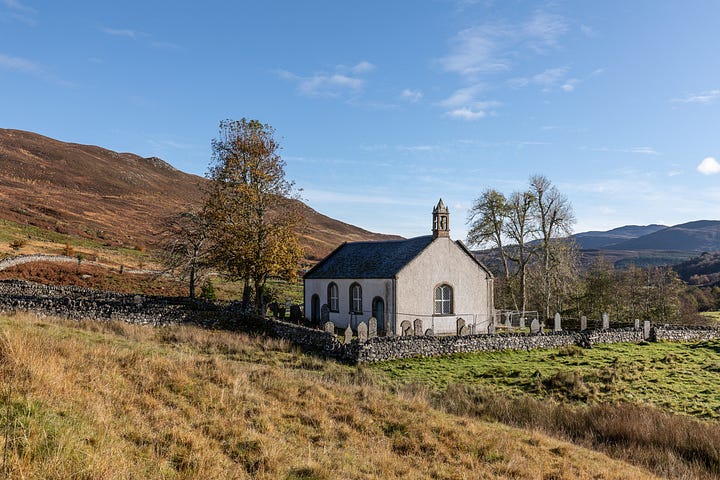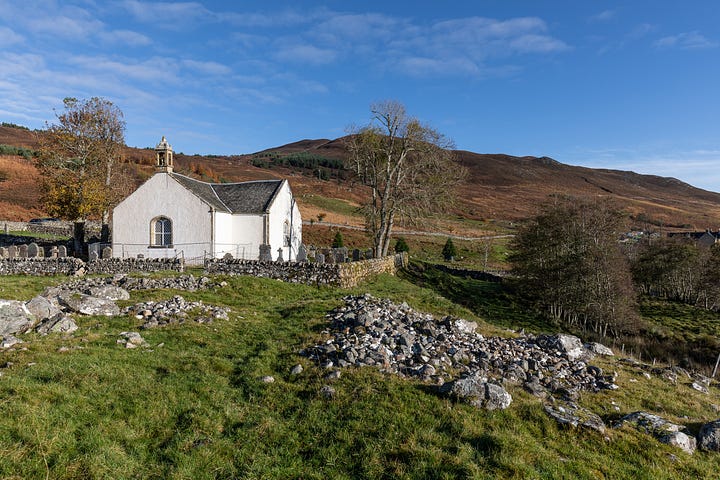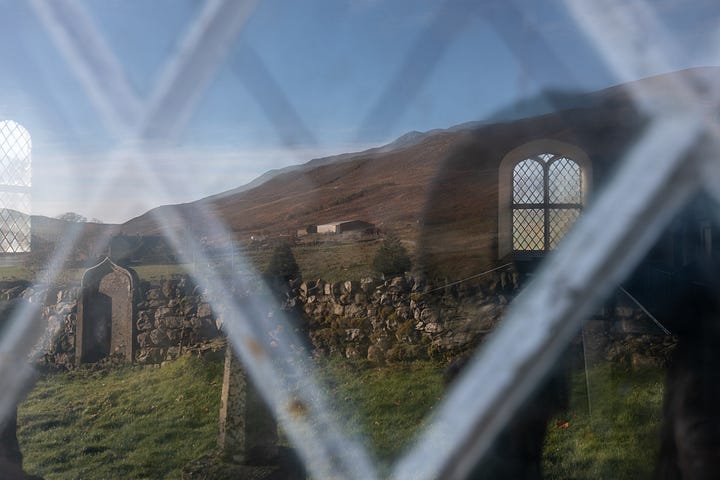Croick Church and Clearance
How a small church in a remote Scottish glen played a role in the Highland Clearances
Note: This post contains pictures which means it may appear as clipped or truncated in an email. To see the whole thing just press VIEW ENTIRE MESSAGE at the end of the email and you’ll see it in one. Or head to the online version.
Hello everyone!
Nowadays, most of Scotland’s glens are empty, silent landscapes occupied by flora and fauna. But it hasn’t always been the case. In the past the glens would have resounded with the sound of people going about their daily lives: cultivating the fields, tending livestock, mending and building structures, collecting firewood etc. There would have been shouting, singing, whistling, crying, cows lowing, roosters crowing, and children playing. Inhabited from prehistoric times, these sounds echoed round the glens through the centuries until the inhabitants left and silence fell. This may have been voluntary, but many were forced to leave the only homes they had ever known. Agricultural changes and financial considerations led many landowners to ‘rationalise’ their landholdings in the 18th and 19th centuries by removing people and introducing large-scale sheep and cattle farming, and deer for sporting interests. The Highland Clearances are well documented and remain a controversial and emotive subject1. Their history has become the byword for landlord oppression and depopulation.
In Strathcarron, one of the Highlands’ many empty straths, is Croick Church. It had a prosaic start in that it came into being through the 1823 Act for Building Additional Places of Worship in the Highlands and Islands of Scotland which legislated for the construction of 40 churches to standardised designs by Thomas Telford2 (a well-known engineer who built all sorts of cool stuff). These churches are commonly referred to as Parliamentary Churches. Croick was built between 1825 and 1827 to serve some 200 parishioners living at that time within walking distance in the surrounding glens. It sits adjacent to the remains of an Iron Age broch3 which is more than likely to have provided some of the building materials for the church.
Click on the image thumbnails to see the full-sized images.




Although built by Thomas Telford, the church is probably better known for its role in the clearances; one of the best documented episodes during that time due to the presence of a reporter from The TImes newspaper.
In 1845, 18 families from Glencalvie, 92 people in all, were to be removed from their crofts at the end of May to make way for sheep farmers and sportsmen. With the sponsorship of five Free Church ministers, the Glencalvie people took the extraordinary step of appealing directly to the general public for help with money for tents and general relief through a petition placed in The Scotsman newspaper. Despite a desperate search, they had been unable to find any alternative accommodation and an asylum for the refugees was planned in the churchyard at Croick. Public sympathy quickly prompted considerable donations for their relief, but the major problem was the provision of alternative accommodation. The two cottages offered by a neighbouring estate clearly were not enough.
The plight of the Glencalvie families was vividly recounted in The Times and, interestingly, in more detail than in the local papers. There had been a previous attempt two years prior to serve notices of removal on the Glencalvie people. The constables were waylaid by the women who removed their legal papers and set fire to them. At this time, the people offered to pay a higher rent than any sheep farmer, but without success. The estate factor preferred to deal with one sheep farmer rather than a mass of small tenants. In 1844, the people were ‘tricked’ into service of notice, with removal delayed until May 1845. Despite the time allowed, alternative accommodation had not been found; landlords were reluctant to take in refugees or give accommodation to likely paupers due to the impending passage of the Scottish Poor Law bill which would require landlords and farmers to support paupers throughout Scotland.
At the end of May 1845, the Glencalvie people left their cottages and set up camp in Croick churchyard. It must have been incredibly cramped, the churchyard is not large by any stretch of the imagination. The Times reporter described it thus:
‘Behind the church, in the courtyard, a kind of long booth was erected, the roof formed of tarpaulin stretched over poles, the sides closed in with horse cloths, rugs, blankets, and plaids.’
At this stage, there were now 80 people including 23 less than ten years old, seven in bad health, ten older than 60 years of age and 8 young married men. The report continued:
‘I am told it was a most wretched spectacle to see these poor people march out of the glen in a body, with two or three carts filled with children, many of them mere infants, and other carts containing their bedding and other requisites. The whole countryside was up on the hills watching them as they steadily took possession of their tent.’
Like similar refugees throughout the Highlands, it is unknown what became of them, though some at least were settled near Edderton, and others in Ardgay and Shandwick where their descendants now live.
Scratched on the glass of the east window of the church are poignant references to this event: 'Glencalvie people was in the churchyard here May 24th 1845; Glencalvie is a wilderness below sheep' and the like. It has been suggested that it is unlikely that these were written by the evicted people themselves, who spoke only Gaelic as the Times reporter records. A possible candidate is the 'John Ross, shepherd, Croick' whose name appears four times, twice with the date 1869. Or maybe some of the younger folks knew some English.
Click on the image thumbnails to see the full-sized images.


I have had Croick Church on my list of places to visit for what feels like forever, but somehow never got round to it. I finally put that right on a beautiful autumnal day at the beginning of November last year. Unfortunately, the roof is in a fairly unsafe condition at the moment so there was no entry to the building. This meant I couldn’t photograph the scratched messages on the glass; a second pane has been put over them on the outside, presumably to protect them, and the reflection made photography impossible. Photographing from the inside might have been possible. Hopefully, the funds to repair the roof can be secured and I can try again.
1 The Highland Clearances by Eric Richards is a good place to start if you’d like to read more.
2 Thomas Telford was a Scottish civil engineer. After establishing himself as an engineer of road and canal projects in Shropshire, he designed numerous infrastructure projects in Scotland, as well as harbours and tunnels.
3 Brochs are a kind of Iron Age roundhouse found only in Atlantic Scotland (which also covers the east side of the Highlands).







What a fascinating story Lynn, I have heard a little about the clearances before, I thought it had something to do with English landlords forcing them out, and contributed to the still simmering tensions between the Scottish and English neighbours.
I cannot begin to imagine the fear and worry the evicted must have been subjected to in being forced to leave their homes, for sheep no less… as if their lives weren’t hard enough…
Your photos are beautiful as always Lynn, and your writing of the history. It’s a terribly sad thought though… not uncommon at that time I believe (though I’m no historian) and I see no sign that they were ever even there apart from the church.